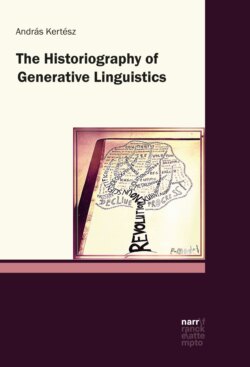Читать книгу The Historiography of Generative Linguistics - András Kertész - Страница 18
2.1.2.3 One of the neo-Bloomfieldianneo-BloomfieldianBloomfieldian trends
ОглавлениеHymesHymes, Dell and FoughtFought, John (1981) [1975] is one of the historiographicalhistoriography approaches questioning the kind of historical account which attributes revolutionaryrevolutionary relevance to Syntactic StructuresSyntactic Structures, and instead interprets the latter as an organic part of neo-Bloomfieldian structuralismstructuralism. Hymes and Fought (1981 [1975]: 155–156) argue for the following thesis, which TomalinTomalin, Marcus (2008: 11) calls »provocative«:
| (T7) | (a) | Neo-Bloomfieldian structuralismstructuralism was not a coherent school, but consisted of a variety of alternative trends and individual initiatives. |
| (b) | Within neo-Bloomfieldianneo-BloomfieldianBloomfieldian structuralism,structuralism Syntactic StructuresSyntactic Structures contributed to the victory of Zellig S. HarrisHarris, Zellig S.’s approach over that of TragerTrager, George L. and Smith’Smith, Henry Lees (1957). |
The authors emphasize that the ›climate of opinionclimate of opinion‹ did not change immediately after 1957 under the influence of the appearance of Syntactic StructuresSyntactic Structures.1 ChomskyChomsky, Noam’s work was evaluated as one of the standpoints within neo-Bloomfieldianism. It was not considered as a challenge that might lead to the redefinition of the discipline (HymesHymes, Dell & FoughtFought, John 1981 [1975]: 154).
In their book on American structuralismstructuralism – in which ChomskyChomsky, Noam’s activity is only one episode – the authors devote much space to the methodologymethodology of linguistic historiographyhistoriography. They suggest the simultaneous consideration of a series of factors. Among others, referring to PercivalPercival, W. Keith (1976a) they reject the application of KuhnKuhn, Thomas S.’s approach to linguistics (HymesHymes, Dell & FoughtFought, John 1981: 24–25, 239–241, 245–246) and criticize KoernerKoerner, E.F. Konrad (1978). They also reject an approach which builds linguistic historiography on one basic term such as ›paradigmparadigm‹ and claim that »a single term will not suffice« (Hymes & Fought 1981 [1975]: 25). Much more complex and differentiated terms are needed in order to capture »the rich range of materials actually forming the datadata to be explained« which every »serious historiography« is expected to use (Hymes & Fought 1981: 25). These materials also include personal and institutional dynamics as well as unpublished documents. The authors discuss the range of data which they believe to be potentially relevant for historiographical research. Naturally, these principles apply to the historiography of linguistics in general and to that of generative linguistics in particular.
| (SP7) | The historiographyhistoriography of generative linguistics does not rely on a single basic term; rather, with respect to Syntactic StructuresSyntactic Structures, it requires a network of terms which is able to grasp the differentiated and complex nature of the historyhistory of linguistics; its central hypothesis is (T7); and its framework is the sophisticated combination of the terms, sources and analytical aspects of historiographical research. |
